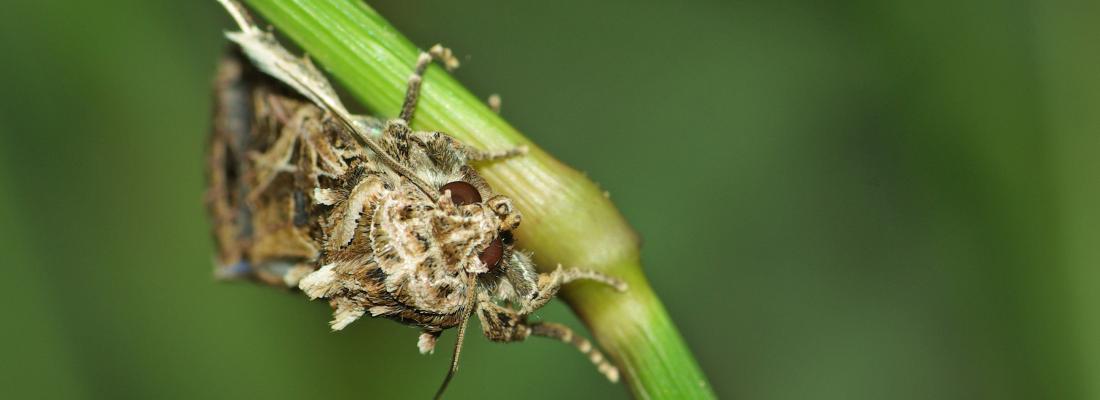To extract any adaptive benefit, the circadian clock needs to be synchronized to the 24-h day-night cycles. We have investigated if it is a general property of the brain’s circadian clock to recognize social interactions as external time givers. Sociosexual interactions with the opposite sex are universal, prevalent even in the lives of solitary animals. The solitary adult life of the Spodoptera littoralis moth is singularly dedicated to sex, offering an ideal context for exploring the impact of sociosexual cues on circadian timekeeping. We have identified specific olfactory cues responsible for social entrainment, revealing a surprisingly strong influence of pheromone-mediated remote sociosexual interactions on circadian rhythms. Males’ free-running rhythms are induced and synchronized by the sex pheromone that the female releases in a rhythmic fashion, highlighting a hierarchical relation between the female and male circadian oscillators. Even a single pulse of the sex pheromone altered clock gene expression in the male brain, surpassing the effect of light on the clock. Our finding of a daytime-dependent, lasting impact of pheromone on male’s courtship efficacy indicates that circadian timing in moths is a trait under sexual selection. We have identified specific components of the sex-pheromone blend that lack mate-attractive property but have powerful circadian effects, providing rationale for their continued retention by the female. We show that such volatiles, when shared across sympatric moth species, can trigger communal synchronization. Our results suggest that the sex pheromone released by female moths entrains males’ behavioral activity rhythm to ensure synchronized timing of mating.
In every animal’s brain, an internal circadian clock operates with a period of approximately 24 hours to daily dictate when an animal should sleep and when it should be awake. To gain any adaptive advantage, the circadian clock must be perfectly synchronized with local day-night cycles – to this end, external cyclical changes in light and temperature conditions are used by the internal clock to adjust itself. day. We investigated whether it is a general property of the brain’s circadian clock to periodically recognize available social cues as external temporal cues. Sociosexual interactions with the opposite sex are universal, prevalent even in the lives of solitary animals like the pest moth Spodoptera littoralis, whose adult life is singularly dedicated to sex, providing an ideal context to explore the impact of sociosexual cues on circadian synchronization.
We demonstrate that limited social interactions surrounding courtship are potent enough to reset the circadian clock of adult male moths that lead a solitary life like the majority of insect and mammalian species. The presence of certain sex pheromonal components signals a specific time of the night to the male moth. The male uses this information to reset its inherently sloppy clock on a daily basis. The male’s circadian clock requires pheromonal cues released by the female to function robustly and to synchronize with the female’s activity rhythm, facilitating successful mating. We further show that pheromone-based circadian communication can extend across a community of closely related sympatric species without triggering futile heterospecific mating. Our results, at the interface of neuroscience and chemical ecology, highlight that ecological interactions inject flexibility into genetically programmed behaviors such as sleep and wakefulness, and highlight that the study of animals with unique sensory specializations would pave the way to unveil the plasticity of the circadian program.
We used automated quantitative behavioral analyses and circular statistics to measure circadian changes in the moth’s sleep-wake cycles. Changes in clock gene expression in the brain were monitored via qRT-PCR. Pheromone emission was qualified and quantified using gas chromatography coupled with mass spectrometry (GC-MS). Electrophysiological and olfactometric behavioral tests were used to measure male reception and physiological response to pheromonal compounds.
RÉFÉRENCE
Ghosh S. et al. (2024). Pheromone-mediated command from the female to male clock induces and synchronizes circadian rhythms of the moth Spodoptera littoralis. Current Biology, https://doi.org/10.1016/j.cub.2024.02.042
CONTACTS
CHATTERJEE Abhishek CR INRAE, Équipe NeO du Département EcoSens
presse@inrae.fr
[1] Le biocontrôle, fondé sur la connaissance des interactions naturelles entre espèces, est un des leviers en agroécologie pour protéger les cultures contre les ravageurs et les maladies.






